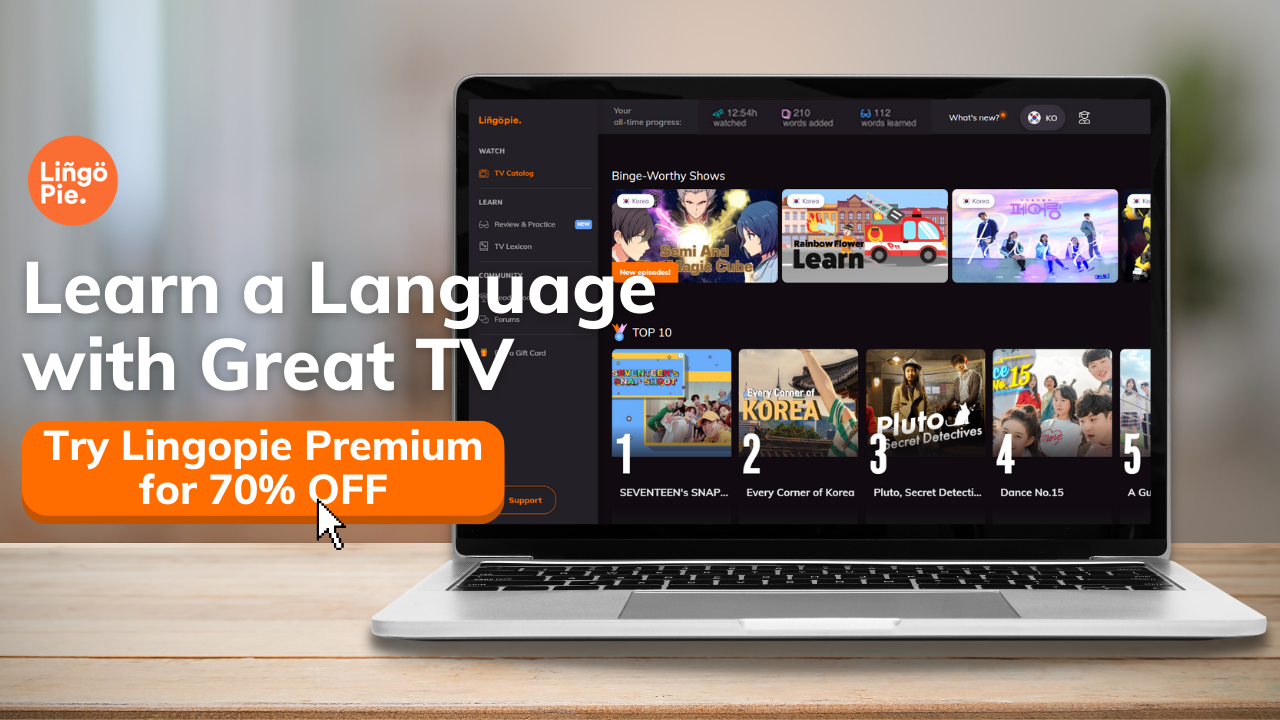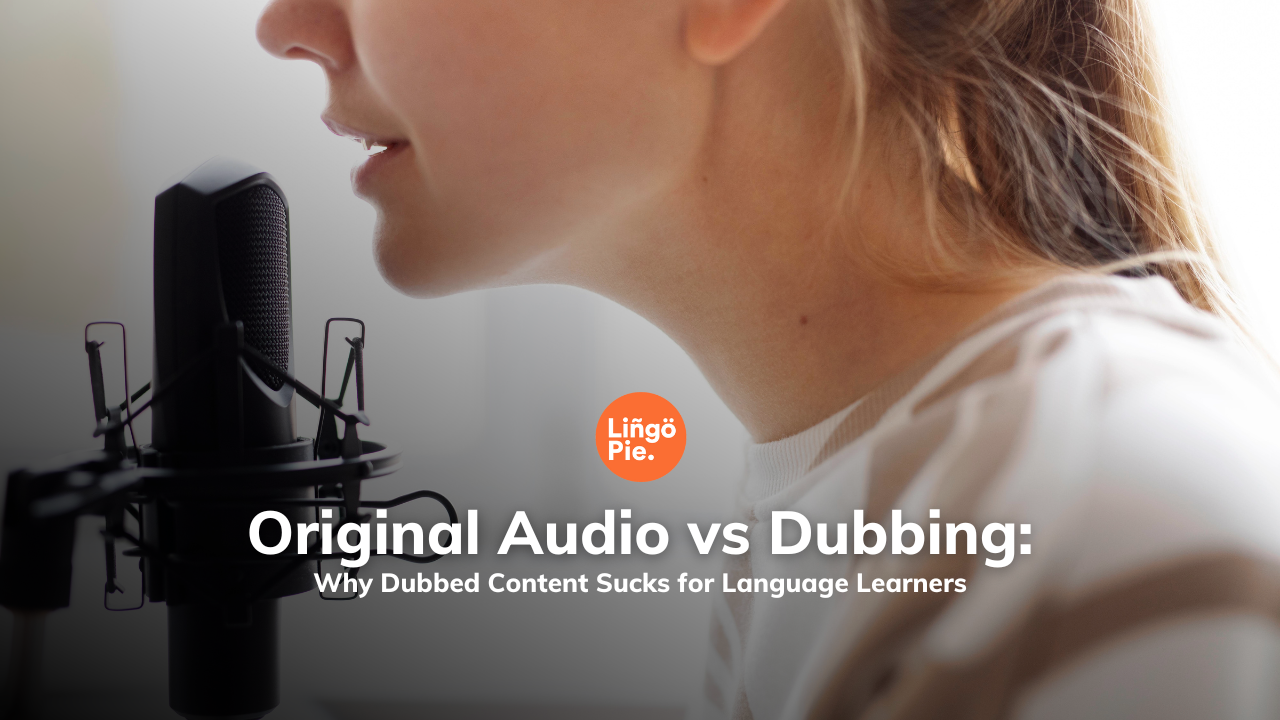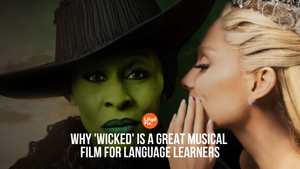Hello language lovers! Today, we are going to talk about dubbing in movies and TV shows. This is sometimes a controversial topic, especially among language enthusiasts and cinephiles.
The general consensus is that dubbing and voice replacement in cinema are features that take away from the original performance and limit people's exposure to other languages.
In this post, we will look at the arguments against watching dubbed movies and shows, and explain why watching in the original language is always better.
We'll leave you with some great tips for learning languages from movies with the original audio. Learners can visit Lingopie, a streaming service that teaches popular languages, for awesome original-language content.

TABLE OF CONTENTS:
- What is Audio Dubbing?
- Why Dubbed Content is Terrible for Language Learners
- The Benefits of the Original Audio Version
- How to Use Original Audio Movies to Learn Languages
- FAQs: Original Audio and Dubbing
- Summing Up: Original Audio is Better than Dubbing for Learners
What is Audio Dubbing?
Audio dubbing is when the original dialogue in a film or show is replaced by new audio in a different language. This is an alternative option to using subtitles.
Dubbing and voice replacement are popular across the globe, particularly in Spain, France, and Italy, where many people prefer to watch Hollywood blockbusters in their own languages.
Moreover, Netflix often provides the dubbed version of shows as well as the originals, so many English speakers watched the likes of Squid Game and Money Heist dubbed in English.
The difference between dubbing and voice-over is that dubbed audio is replaced by new audio that often does not exactly match the lip movements of the original actor.
Whereas, voice-over is when additional audio is inserted into a scene to indicate a character's thoughts, or to narrate. This is a valid form of creative storytelling and is not controversial.
The kind of audio translation used on a project will depend on whether it is a high-budget movie or something less artistic, like training videos or other instructional content.
UN Style Voice Over
UN-style voice-over is when the original speaker can still be heard at low volume, but there is a voice actor overlaid on top of the original track providing the translation.
The UN-style voice-over technique is used in news segments and other situations in which it needs to be made clear that the voice actor is translating the on-screen person's words.
Full Lip Sync Dubbing
There is such a thing as full lip-sync dubbing, in which the foreign language dubbed audio is written to match the actor's lip movements as much as possible.
With lip-sync dubbing, the original script will be adjusted so that the new audio matches the lip movements better.
The thing with lip sync dubbing is that the original dialogue has to be changed quite significantly to make the lip movements work in the new language. It is also a costly post-production process.
Time-Synced Dubbing
Then, there is time-synced dubbing. Time-synced audio dubbing aims to ensure that the new audio for each line of dialogue is the exact same length as the line of the original speaker.
However, the need to match the lip movements is removed, making this a cheaper and easier option for studios.
As with lip-sync dubbing, time-synced dubbing will alter the original dialogue more to make it work with the relevant time frame.
Non-Synced Dubbing
Finally, we have non-synced dubbing. This form of dubbing is the least synced to the lip movements and time frame of the original dialogue, but it can be the most faithful to the original script.
Rather than writing dialogue to fit the actors' movements, this type of dubbing stays very faithful to the original dialogue, but in the target language.
Sometimes faithful translations are much longer or shorter than the original audio, but with non-synced dubbing, this is ok. It is more important to translate the original dialogue as faithfully as possible.
Why Dubbed Content is Terrible for Language Learners
The reason most linguists would say dubbing and voice replacement is terrible for language learners is that they take away from the original dialogue.
They reduce people's exposure to foreign languages and, even with lip-sync dubbing, the voices do not perfectly match the faces, movements, or tone all the time.
Dubbing and voice replacement can be distracting and take the audience out of the plot, making it harder to enjoy the foreign content and become immersed in the language, culture, or fictional world of a TV show or movie.
You might wonder if watching a movie you love dubbed into your target language is a good idea, as you will be able to follow the plot and learn new vocabulary in an accessible way. However, this is not a great idea either.
As we have seen, the dubbed version of a movie or TV show will not perfectly sync up the lip movements with the new audio, thus making the content harder to engage with.
This exposure to the language is far less natural and of poorer quality than any movie or TV show actually made in your target language.
The Benefits of the Original Audio Version
By contrast, the original audio version is always the best. The original audio track of a movie or TV show perfectly aligns with the actors' expressions, movements, tone, and emotion, because it is their voices!
No matter how much time and money goes into top-quality dubbing and voice replacement, voice actors cannot perfectly match their words to the mouth movements of the original actors, and therefore, the foreign content suffers.
Keeping the original dialogue, as performed by the on-screen actor, is important for the art and immersive nature of movies and TV shows. What's more, when foreign films are made in languages that are tonal, it is even more important to hear the original audio track.
For instance, if you are learning Chinese, listening to the original voices in a Chinese-language show will benefit your understanding of how tone impacts meaning. This is not something you can learn just from subtitles. If you watch Chinese content dubbed, you lose out on this vital learning.
Not only does audio dubbing often lead to poorer quality content, but it also takes away the opportunity to immerse yourself in another language and pick up useful words and phrases while having fun.
Learning a language is much easier if you are engaged and enjoying the resources you are using. This is why watching TV shows and movies are such a great way to learn a language.
Listening to dubbing and voice actors in your native language removes the learning potential of foreign feature films. Language replacement also takes away the nuances of the source language.
How to Use Original Audio Movies to Learn Languages
Now you know why watching foreign movies with the original sound is a great way to learn languages, we will give a few examples of how it can benefit your language skills.
Head over to streaming services like Lingopie or Netflix to watch some great foreign language content with the original track. You can use subtitles to make the content more accessible.
Vocabulary
One of the most beneficial aspects of watching foreign-language movies is the huge plethora of new vocabulary you are exposed to. Not only will you learn useful day-to-day vocabulary, but you will also become aware of slang and curse words, idioms, and regional phrases.
These are all elements of language that can bring new meaning to cultural references and societal differences around the world. You might wonder why you should learn swear words in another language, but there is a good reason.
If you want to keep up with social situations, understand music and movies, and eventually speak another language like it is your native tongue, you need to at least understand some of the curse words.
Generally, content is dubbed to make it accessible to a global audience, but when you watch movies as they were filmed in their original native languages, you get a much deeper insight into the vernacular and the societies behind the words and phrases.
Grammar
You might not think that you can learn grammar from watching movies, but you can! Learners will naturally develop their understanding of sentence structure, tenses, moods, and other essential building blocks of language from listening to native speakers on their screens.
Quite often, original-language voiceovers and off-screen narration are delivered slowly and clearly by the original speaker. Think Morgan Freeman in Shawshank Redemption, or James Garner in The Notebook.
So, movies or shows that rely on voiceovers recorded off-camera can be particularly useful tools for spotting grammatical patterns in speech.
Throughout any movie or TV show, you will come across various tenses, moods, and other useful grammatical points. So, whether you want to watch an entire movie or just a quick 20-minute comedy, any exposure to your preferred language will help your grammar acquisition.
Pronunciation and Accent
Finally, watching foreign shows and movies with the original soundtrack is ideal for accent and pronunciation practice.
Hearing the original speaker say their lines effortlessly helps learners to become accustomed to the sounds of the actor's native language.
Listening to the original voices is also great for foreign language listening comprehension. Remember, all languages boast a variety of different accents, so the more exposure you get to these accents, the more you will be able to understand them and perfect your own.
You can speech shadow the original voice in any movie or show to practice. This means repeating the lines after they are spoken and trying to mimic the pronunciation.
For instance, when you watch a Japanese anime series, focus on the tones and accents. This is a big part of learning to speak Japanese. You can repeat lines over and over to learn how to pronounce words and phrases with complete accuracy.
When working on pronunciation and accent, it is easier to use scenes in which you can see the character's mouth movements, rather than listening to the off-camera voice-over or narration.
This is due to the fact that you can learn a lot about how to make a sound by copying the jaw and tongue movements of actors, or even anime cartoons.
FAQs: Original Audio and Dubbing
What is the difference between dubbing and voice-over?
The difference between dubbing and voice-over is that dubbing means voice replacement, while voice-over is the insertion of additional audio.
While both dubbing and voice-over involve adding audio into a show or movie in post-production, dubbing is also called language replacement, while voice-over is a method used for creative storytelling.
Why is the original version always better?
When watching foreign films and TV shows, the original version is always better. The original sound provides more exposure to a foreign language, which is great for listening comprehension, accent practice, and vocabulary acquisition, among other language building blocks. Moreover, the original sound helps to preserve the art of the movie.
Do actors dub their own voices?
No, actors do not dub their own voices. When a movie is dubbed in various languages, several different actors will voice the same role in different languages. Generally, voice actors follow screen actors throughout their careers.
For instance, Thomas Danneberg is the German dubbed voice for John Cleese, Arnold Schwarzenegger, and John Travolta, among others.
What is automated dialogue replacement?
Automated dialogue replacement is similar to dubbing, but for the purpose of fixing the audio quality, rather than changing the language. Despite the name, this dialogue replacement is not actually automatic.
In fact, it takes a fair amount of effort and skill. When the original audio for a scene is no good, due to background noise or other sound problems, the actor needs to re-do the audio to be added over their original performance.

Summing Up: Original Audio is Better than Dubbing for Learners
Now you should have a good idea of why language enthusiasts believe dubbing and voice-over work ruins the learning potential and art of a movie.
When the original audio is removed from a movie or TV show, so too are the tone, emotion, and some of the character choices by the original actor.
This limits the depth of the performance and takes away a lot of language learning potential.
Instead, learners should always watch movies and TV shows with original dialogue. This provides quality exposure to foreign languages, which can help with vocabulary acquisition, as well as pronunciation and tone.
Remember to check out Lingopie if you'd like to watch some great original audio foreign movies and shows!






![Language Difficulty Ranking For English Speakers [2025]](/blog/content/images/size/w300/2025/05/Language-Difficulty-Ranking----For-English-Speakers.png)
![Language Learning with Netflix [2025 Guide]](/blog/content/images/size/w300/2023/05/Netflix-AD.jpg)

